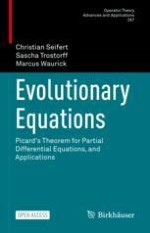8.1 A Theorem of Paley and Wiener



 . This inequality yields
. This inequality yields  for \(t\in \left (-\infty ,0\right )\) defines a function \(g\in L_1\left (-\infty ,0\right )\). Thus, [g = ∞] is a set of measure zero and thus \([f=0]\cap \left (-\infty ,0\right )=\left (-\infty , 0\right )\setminus [g=\infty ]\) has full measure in \(\left (-\infty ,0\right )\) implying that \( \operatorname {\mathrm {spt}} f\subseteq \mathbb {R}_{\geqslant 0}\).
for \(t\in \left (-\infty ,0\right )\) defines a function \(g\in L_1\left (-\infty ,0\right )\). Thus, [g = ∞] is a set of measure zero and thus \([f=0]\cap \left (-\infty ,0\right )=\left (-\infty , 0\right )\setminus [g=\infty ]\) has full measure in \(\left (-\infty ,0\right )\) implying that \( \operatorname {\mathrm {spt}} f\subseteq \mathbb {R}_{\geqslant 0}\).


 and
and
 . Moreover, we set
. Moreover, we set
 . We first prove that \(f\in \bigcap _{\nu >0}L_{2,\nu }(\mathbb {R};H)\) with \(\sup _{\nu >0}\left \Vert f \right \Vert { }_{L_{2,\nu }(\mathbb {R};H)}<\infty .\) For doing so, let a > 0, ρ > 0 and \(x\in \mathbb {R}\). Applying Cauchy’s integral theorem to the function z↦ezx
g(z) and the curve γ, as indicated in Fig. 8.1, we obtain
. We first prove that \(f\in \bigcap _{\nu >0}L_{2,\nu }(\mathbb {R};H)\) with \(\sup _{\nu >0}\left \Vert f \right \Vert { }_{L_{2,\nu }(\mathbb {R};H)}<\infty .\) For doing so, let a > 0, ρ > 0 and \(x\in \mathbb {R}\). Applying Cauchy’s integral theorem to the function z↦ezx
g(z) and the curve γ, as indicated in Fig. 8.1, we obtain
 in \(L_2(\mathbb {R};H)\) as n →∞, we may choose a subsequence (again denoted by (a
n)n) such that
in \(L_2(\mathbb {R};H)\) as n →∞, we may choose a subsequence (again denoted by (a
n)n) such that 
 for \(z\in \mathbb {C}_{\operatorname {Re}>0}\). Then \(\widetilde {g}\in \mathcal {H}_2(\mathbb {C}_{\operatorname {Re}>0};H)\) and thus, Theorem 8.1.2 yields the existence of \(\widetilde {f}\in L_2(\mathbb {R}_{\geqslant 0};H)\) with
for \(z\in \mathbb {C}_{\operatorname {Re}>0}\). Then \(\widetilde {g}\in \mathcal {H}_2(\mathbb {C}_{\operatorname {Re}>0};H)\) and thus, Theorem 8.1.2 yields the existence of \(\widetilde {f}\in L_2(\mathbb {R}_{\geqslant 0};H)\) with  , we obtain \(\mathcal {L}f=g\). □
, we obtain \(\mathcal {L}f=g\). □8.2 A Representation Result
 for all \(a\in \mathbb {R}\)) and, secondly, T needs to be autonomous (i.e., τ
h
T = Tτ
h for all \(h\in \mathbb {R}\) where τ
h
f = f(⋅ + h)). The main theorem of this section reads as follows:
for all \(a\in \mathbb {R}\)) and, secondly, T needs to be autonomous (i.e., τ
h
T = Tτ
h for all \(h\in \mathbb {R}\) where τ
h
f = f(⋅ + h)). The main theorem of this section reads as follows: and compute
and compute 
 is dense in \(L_2(\mathbb {R}_{\geqslant 0};H)\). Hence, for (8.4), it suffices to show
is dense in \(L_2(\mathbb {R}_{\geqslant 0};H)\). Hence, for (8.4), it suffices to show 
 and, by a straightforward computation, \((\mathcal {L}\tau _{-a}f)(z)=\mathrm {e}^{-za}\mathcal {L}f(z)\) for all \(f\in L_2(\mathbb {R}_{\geqslant 0};H)\). Thus,
and, by a straightforward computation, \((\mathcal {L}\tau _{-a}f)(z)=\mathrm {e}^{-za}\mathcal {L}f(z)\) for all \(f\in L_2(\mathbb {R}_{\geqslant 0};H)\). Thus, 

 as well as
as well as
 . Then
. Then 
 . Thus, \(\left \Vert M(z) \right \Vert \leqslant \left \Vert T \right \Vert \), which yields boundedness of M and the assertion of the theorem. □
. Thus, \(\left \Vert M(z) \right \Vert \leqslant \left \Vert T \right \Vert \), which yields boundedness of M and the assertion of the theorem. □ . Then \(\tau _{a}\varphi \in L_2(\mathbb {R}_{\geqslant 0};H)\), and for ν > 0 we compute
. Then \(\tau _{a}\varphi \in L_2(\mathbb {R}_{\geqslant 0};H)\), and for ν > 0 we compute 
 for \(z\in \mathbb {C}_{\operatorname {Re}>\nu _{0}}\). □
for \(z\in \mathbb {C}_{\operatorname {Re}>\nu _{0}}\). □8.3 Comments
 where the limit is meant in the strong operator topology on \(L_2(\mathbb {R};H)\).
where the limit is meant in the strong operator topology on \(L_2(\mathbb {R};H)\). for \(z\in \mathbb {C}_{\operatorname {Re}>\nu _0}\). We assume that \(h\in \mathcal {H}_2(\mathbb {C}_{\operatorname {Re}>\nu _0};\mathbb {C})\). For ν > ν
0 we define the distribution \(u\colon C_{\mathrm {c}}^\infty (\mathbb {R})\to \mathbb {C}\) by
for \(z\in \mathbb {C}_{\operatorname {Re}>\nu _0}\). We assume that \(h\in \mathcal {H}_2(\mathbb {C}_{\operatorname {Re}>\nu _0};\mathbb {C})\). For ν > ν
0 we define the distribution \(u\colon C_{\mathrm {c}}^\infty (\mathbb {R})\to \mathbb {C}\) by 

 ?
? extends to a holomorphic function \(\widetilde {f}\colon \mathbb {C}\to \mathbb {C}\) with \(\widetilde {f}(\mathrm {i} t)=f(t)\) for each \(t\in \mathbb {R}\) such that
extends to a holomorphic function \(\widetilde {f}\colon \mathbb {C}\to \mathbb {C}\) with \(\widetilde {f}(\mathrm {i} t)=f(t)\) for each \(t\in \mathbb {R}\) such that  satisfies \( \operatorname {\mathrm {spt}} g\subseteq \left [-a,a\right ]\).
satisfies \( \operatorname {\mathrm {spt}} g\subseteq \left [-a,a\right ]\).
